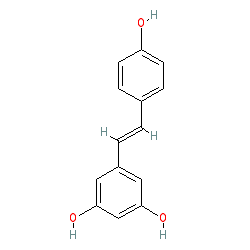|
Synonyms: 3,4',5-stilbenetriol | 3,5,4'-trihydroxystilbene | trans-resveratrol
Compound class:
Natural product or derivative
Comment: Resveratrol is a natural product found in the skins of grapes and some other berries used predominantly as an antioxidant dietery supplement [9,14,16]. The compound exists as a mixture of trans- (shown here) and cis- (PubChem CID 1548910) conformations. Resveratrol has been investigated for its various roles in complex biological processes [2,5,7,12-13,19,21]. It has some activity as a cyclooxygenase inhibitor/antiinflammatory agent.
Ligand Activity Visualisation ChartsThese are box plot that provide a unique visualisation, summarising all the activity data for a ligand taken from ChEMBL and GtoPdb across multiple targets and species. Click on a plot to see the median, interquartile range, low and high data points. A value of zero indicates that no data are available. A separate chart is created for each target, and where possible the algorithm tries to merge ChEMBL and GtoPdb targets by matching them on name and UniProt accession, for each available species. However, please note that inconsistency in naming of targets may lead to data for the same target being reported across multiple charts. ✖
View more information in the IUPHAR Pharmacology Education Project: resveratrol |
|
|||||||||||||||||||||||||||||||||||
| No information available. |
Mechanism Of Action and Pharmacodynamic Effects  |
| Resveratrol is believed to be anti-atherogenic, by promoting apoA-1 and HDL-mediated efflux in addition to regulating the expression of proteins important for cholesterol transport [20]. These actions of resveratrol appear to involve PPARγ and α2A-adrenoceptor pathways. Resveratrol is also reported to protect lung epithelial cells [10] and coronary arterial endothelial cells [18] from oxidative damage via a Nrf2 (nuclear factor (erythroid-derived 2)-like 2; NFE2L2)-dependent mechanism. |








